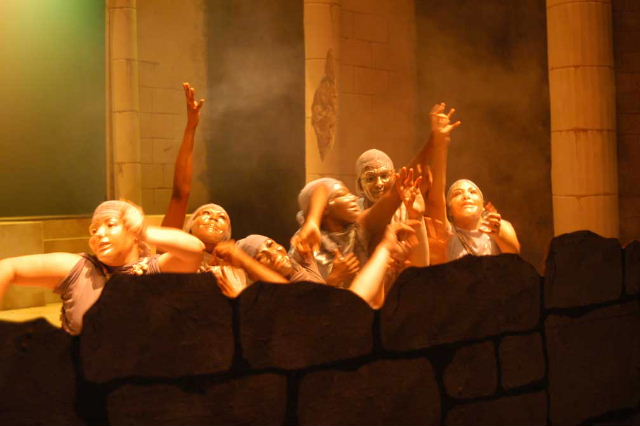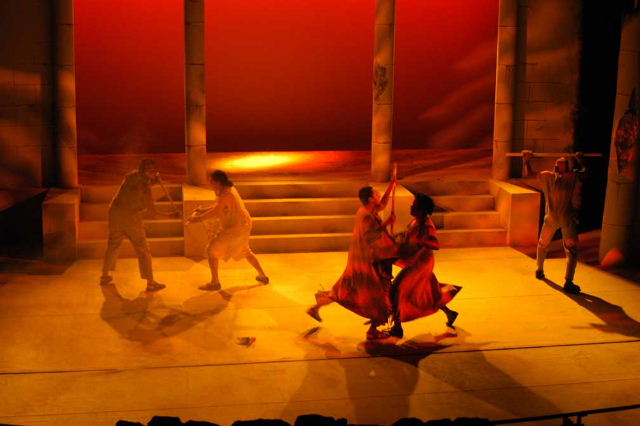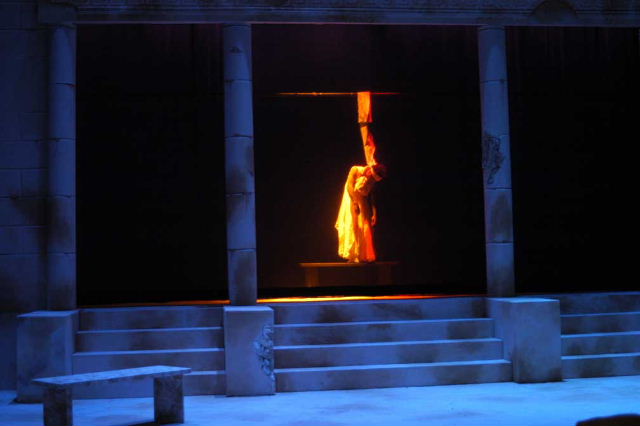Taking her cue from Falstein's adaptation, Watson Turner reshaped the traditional narrative and choral elements of Antigone. This included introducing the “Storyteller,” a role which set the production within a narrative and contextual framework for a contemporary audience. She also divided Sophocles' chorus into the King Creon Chorus and the People's Chorus, based upon economics, social status and physicality. Reflected in their body language, gesture, costuming and dramatic function, the King Creon Chorus was distinguished, learned, poised, and they reluctantly offered Creon advice, which he failed to heed. The People's Chorus, on the other hand, was more plebeian in their body language, behavior, costuming and dramatic function.
Throughout the production, Watson Turner mingled the People's Chorus with the audience in the auditorium, thereby establishing a connection between the spectators and the action of the play. As the People's Chorus observed the unfolding action, they pleaded with Creon on Antigone's behalf and encouraged the audience to join them. When the chorus moved onto the stage, the audience's energy and focus followed the chorus, disintegrating the “fourth wall” and engaging the audience to join the chorus to plead for Antigone's life.
Watson Turner also reconstituted the play's choral-episodic structure, introducing choral dance sequences and enacting events normally narrated in the play's choral odes. For instance, Watson Turner introduced a dance sequence, a pre-parados before the prologos, which was underscored with composer Richard V. Turner's riveting score. This pre-parados featured the chorus members in identical translucent plastic masks rising up from the Lovinger Theatre's hydraulic orchestra pit in a haze of fog, presenting an image of Thebes as an uninhabitable land suffering from environmental abuse.
Plate 1 Members of the Chorus. Photograph by Robert C. Roarty
Later, as the Storyteller narrated the battle between Polynices and Eteocles, six actors with long wooden dowels enacted the battle in a stylized fight sequence choreographed by Dyane Harvey.
Plate 2 The Fight Scene. Photograph by Robert C. Roarty
At battle's end, both Polynices and Eteocles were killed, Polynices was rolled onto the orchestra pit, and Eteocles was lifted and carried off stage. The female chorus members sang and danced a hymn of praise to Dionysos in celebration of the victory. This dithyramb then segued into a “Dionysian ballet,” or victory celebration-dance, scored to a Latin-Caribbean tempo, culminating in a magic trick.
African, Latin and Caribbean rhythm influenced the musical score, along with such natural sounds as crashing waves, a receding tide, the calls of sea birds, thunder and lightning as well as plucked strings. Sound effects also shook the stage and toppled the elements in full surround sound. Susan Soetaert's costume design represented the lines and style of ancient Greek fashion with contemporary construction and fabric. The costumes, reflecting the director's concern with staying within the Greek frame, brought contemporary hints of fashion to the production's overall visual design and aided a twenty-first century audience's understanding of the play.
Richard Ellis's set design for Antigone employed architectural elements of the classical Greek theatre adapted to the Lovinger Theatre, a 500-seat proscenium theatre, with a steeply raked auditorium and stage-level vomitoria. Upon initial examination, the set resembled the skene of the ancient Greek theatre framed by columns at the curtain line rendered to show a structural decay echoing the decay in Creon's Thebes. While a significant portion of the action occurred on the Lovinger's forestage, action also occurred on a raised three-foot platform, reached by steps, which was bisected with a portal, in itself divided by the two columns. Sliding walls on wagons, resembling pinakes, were drawn on or offstage, creating either a solid wall or up to three upstage entrances. Upstage of the portal was another playing space that was separated from the downstage playing space by a black scrim.
In this upstage space, Watson Turner choreographed the deaths of Antigone, Haemon and Eurydice in slow motion suffused with blood-red light.
Plate 3 Antigone hanging. Photograph by Robert C. Roarty
Watson Turner commented on this obvious departure from staging traditional productions of Greek tragedy:
I elaborated upon Falstein's adaptation to portray Antigone's hanging, Haemon's suicide, as well as Eurydice's self-destruction, in order to tragically illustrate the consequences of Creon's abuse of power. By our illustrating rather than narrating these events on stage, we can force a contemporary audience to participate fully in and feel the tragedy. My goal was to have the audience members experience this pain and share in the responsibility. The chorus, by failing to speak out or by speaking out too late, was as guilty as Creon. (Watson Turner 2004a)As Creon stood alone onstage, his hands dripping in blood, Lehman College's Antigone ended with Ken Ross's slide show presentation of photos of Hitler, Stalin, Idi Amin, Rafael Trujillo and Saddam Hussein, underscoring the link between these modern or contemporary authoritarian dictators and Creon himself.
Watson Turner accomplished a potent examination of the role of leadership in an authoritarian society. Lehman students who attended the production commented on the multiracial casting, the interaction between the chorus and the audience and the hard-hitting visual display of leaders gone astray. The most poignant comment provided by an audience member dealt with the clarity provided by this production to Sophocles’ story. Watson Turner, perhaps echoing her earlier observation about the chorus’s failure to speak out, remarked, “One patron, not a student, approached me to say that she understood now that silence is not always golden.” (Watson Turner 2004b)
References
Bruckner, D.J.R.(1995) “Eurydice Replaces the Chorus, With Strange Consequences” New York Times 11 November 1995 (1996) “Escapades With a Hilarious Corpse” New York Times 24 April 1996 (2004) “Pity the Thebans, Your Friends and Neighbors” New York Times 30 July 2004
Gates, Anita (1998) “In Resistance to the Nazis, Resonance With the Ancients” New York Times 29 August 1998
Genzlinger, Neil (2004) “Sophocles Goes Truly Retro, Back to the Beginning of Time” New York Times 20 May 2004
Hoban, Phoebe (2004) “Five Faces of Antigone, From Surfer Babe to Widow” New York Times 27 October 2004
Holden, Stephen (1992) “'Antigone,' With Clowns" New York Times 16 February 1992
Jefferson, Margo (2004) “Look Out, Antigone, Creon Still Means What He Says" New York Times 27 May 2004
Riding, Alan (1999) “Sophocles Gets a Twist in Paris, by Way of West Africa" New York Times 8 June 1999
Watson Turner, Susan (2004a) Personal interview, 15 February 2004
(2004b) Personal interview, 31 August 2004Weber, Bruce (2002) “In the Beginning, Maybe, There Was 'Antigone'" New York Times 16 December 2002
Wolf, Matt (2002) “An Ancient Drama Whose Wisdom Is Always Modern" New York Times 27 October 2002


